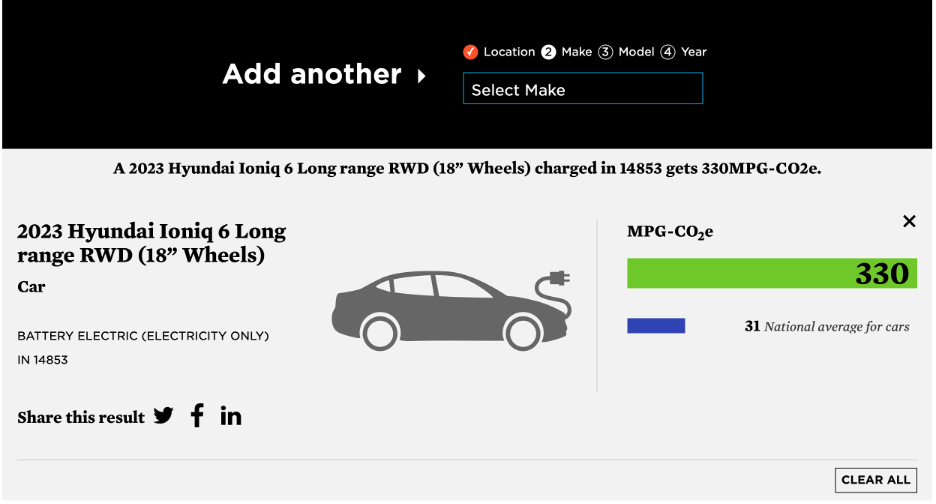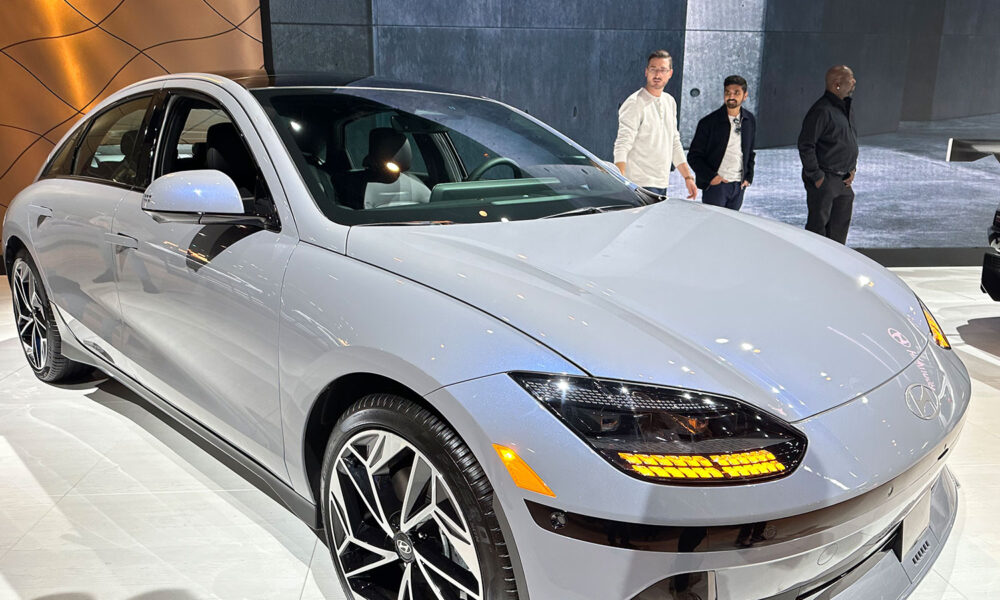How much cleaner is it to drive an electric vehicle (EV) versus a gasoline vehicle?
This is a common question for drivers and car buyers, and one we’ve been answering for quite a while. It’s a complicated question, in part because electricity generation varies across the US and also because some EVs are more efficient than others.
To help drivers look at the options, we’ve updated our tool that lets you look at the emissions from driving different models of EVs in different parts of the country.
This tool compares the climate-changing emissions from electric vehicles to gasoline-powered cars by analyzing all the emissions from fueling and driving both types of vehicles. For a gasoline car, that means looking at emissions from extracting crude oil from the ground, moving the oil to a refinery, making gasoline and transporting gasoline to filling stations, in addition to combustion emissions from the tailpipe.
For electric vehicles, the calculation includes both power plant emissions and emissions from the production of coal, natural gas and other fuels power plants use. Our analysis relies on emissions estimates for gasoline and fuels production from Argonne National Laboratory (using the GREET2022 model) and power plant emissions data released by the US EPA. The data, released earlier this year, tallied the emissions from US power plants during 2021.
New option for the lowest emissions
Switching from gasoline to electricity means greatly reduced global warming emissions, but to minimize emissions from driving, car buyers should choose the most efficient EV that they can. For 2023 models, the most efficient vehicle available is the Hyundai Ioniq 6 (more specifically, the rear-wheel drive version with 18 inch wheels). This car can drive 4.2 miles on 1 kilowatt-hour (0.23 kWh/mi) and on the cleanest grid in the US, the emissions from driving are equal to those of a hypothetical 330 MPG gasoline car.

Some plug-in hybrids are going in the wrong direction
While all-electric vehicles show significantly lower emissions than a similar gasoline vehicle, the results for plug-in hybrid vehicles are mixed. A plug-in hybrid electric vehicle (PHEV) has both a gasoline engine and one or more electric motors. The battery that powers the electric motors can be recharged by plugging the vehicle in so that some of the driving is done using grid electricity. However, the batteries used in PHEVs are smaller than fully-electric vehicles, often giving the ability to drive 20 to 40 miles on a full charge. When the battery is discharged, the PHEV then switches to gasoline as the source of energy.
In theory, this could mean the ability to switch at least some driving to electricity and lower climate-changing emissions. But two trends are making PHEVs have real-world emissions much higher than fully-electric vehicles, and in some cases almost the same as gasoline-only vehicles.
First, some current PHEVs are much less efficient in using electricity to drive than fully-electric vehicles. For example, the Jeep Wrangler 4xe can go less than 1.5 miles on a kilowatt-hour of electricity (0.68 kWh/mi). That’s nearly triple the energy use of the most efficient EV and 37% higher than the electric Ford F-150 pickup truck. Less efficiency when driving on electricity means higher effective global warming emissions to go the same distance.
Second, to calculate the fraction of driving on electricity versus gasoline, we use a ratio called the utility factor which is based on average US daily driving behavior. But if PHEVs are not plugged in, this factor will underestimate gasoline consumption and real-world emissions will be higher than these calculations. Recently Stellantis, maker of Jeeps, announced that it would not stock gasoline-only models in California and other clean-car states and they also have a history of advertising these vehicles as “hybrids”, leaving out the “plug-in” part of PHEV. Additionally, some PHEV models are now being leased at a lower cost than the non-plug-in version. If Jeeps get sold to buyers that don’t know or don’t care that they can plug-in, then the true emissions will be higher than our calculator shows.
What does this mean for emissions? If you use the 2023 Jeep Wrangler 4xe as an example, we calculate overall global warming emissions (from both electricity and gasoline use) equal to 28 MPG gasoline vehicle when using a relatively clean electricity grid in California. However, that’s only if the Jeep is plugged in and starts each day fully charged. If the SUV isn’t plugged in, the gasoline consumption of the Wrangler 4xe is 20MPG. Most of the gasoline-only versions of the Wrangler get between 19 and 23 MPG, so the PHEV version has small emissions savings if plugged-in regularly and no savings (or even increased emissions) if not plugged-in.

Bottom line: Electrify as much as possible and efficiency matters
What does this all mean?
First, electrifying as much of our driving as possible is the best way to cut emissions from our personal vehicles. That means going to a fully electric vehicle where practical and plugging in PHEVs as much as possible.
Second, drivers should pay attention to the efficiency of both fully electric and plug-in hybrid vehicles. While electric vehicles can eliminate tailpipe pollution, they still result in some emissions and electrification shouldn’t be seen as justification to drive a Hummer. Better efficiency means lower recharging costs, more range for the same size battery and lower global warming emissions per mile of driving.

